THE DEVELOPMENT OF FENCING WEAPONS |
| by Malcolm Fare |
Foil
|
Just when and where the lightweight foil emerged as a weapon in its own right remains an intriguing mystery in the history of fencing. Purpose-made practice swords with buttoned tips had been available since the rapier became a popular civilian sword in the 16th century. So how did the foil develop?
|
| In a treatise written in 1550, the Italian fencing master Viggiani is the first to mention the use of practice weapons – arme di gioco (weapons of play) and spada da marra (hoe sword). During the second half of the 16th century, fencing terms for foils gradually came into use: floures in Saint-Didier's treatise of 1573, foile in Shakespeare's "the fencer's foiles, which hit, but hurt not", floret in Montaigne's "un rude tireur le floret au poing" and fioretti defined by Florio in 1598 as "foiles to play at rapier and dagger with". But these terms described buttoned rapiers rather than the sporting weapon we know today.
|
|
In France, during the reign of Louis XIII (1610-1643), there emerged a fashion for wearing short coats, which could not be worn elegantly with the long and cumbersome rapier. Blades were gradually reduced in length until a completely new weapon had evolved: the small sword. This lighter and more manoeuvrable weapon was far more dangerous than its predecessor. To avoid the loss of an eye or other facial damage and to allow the skills of swordplay to be demonstrated in relative safety, rules had to be established.
|
|
No one knows who first devised these rules or introduced the practice weapon that we now recognise as the foil. But by the early 17th century a reliable process of transforming iron into steel had been developed, allowing bladesmiths to forge relatively inexpensive flexible tapered quadrangular blades of consistent quality.
|
|
In 1621, a French encyclopedia (René Francois's Essai des merveilles de nature) used the modern word fleuret for the first time. This book describes certain conventions to be observed in a salle d'armes, including the need to avoid hits to the face, but this is a safety precaution in the days before masks rather than a set of rules governing foil play. So, although something called a fleuret was to be found in the salle, there were as yet few restrictions on how it could be used. |
|
In his book Le maistre d'armes libéral, 1653, the French provincial fencing master Charles Besnard taught the parry and riposte as two distinct movements, something not possible with the heavy rapier. He also posed the question: "Why does a man with little skill, courageous but lacking in judgment, often win with sword in hand over someone who would beat a hundred like him with the foil [fleuret]?" His view was that frequent use of a harmless weapon like the foil took away a swordsman's sense of danger. That he needed to put the question at all implies that the foil with its artificial conventions was in use by the mid-17th century. |
|
|

Mid-17th c. English foil with a German blade |
|
But it was not until 1670 that a book was published illustrating for the first time what is clearly the ancestor of the modern foil, with hits made only to the body using long flexible blades. Written by the appropriately named Philibert de La Touche, though still without identifying the rules of foil play, Les vrays principles de l'espée seule shows that fencing was a popular entertainment at the court of Louis XIV. |
|
All the more curious, then, that the first mention of the actual rules governing foil practice should occur in an obscure treatise by the Scottish amateur enthusiast Sir William Hope in 1692, The Fencing Master's Advice To His Scholar. In a section on Laws to be Observed in all Fencing Schools, Hope made it clear that although a man engaged with 'sharps' could thrust at any part of the body, in schools "no thrusts should be allowed, or accounted as fair, which are not given in the trunk of the body, that is beneath the neck and above the headband of the breeches and within the two shoulders". Foils, or fleurets as he called them to indicate their French origin, had to be of equal length and bouts were for three hits. A piece of sponge dipped in vermilion was attached to the buttoned tips to aid the judges and each hit was marked before continuing play. |
|
It is hard to believe that in France fencers had to wait another four years to be able to refer to the rules, yet L'Art en Fait d'Armes, 1696, by Jean Labat of Toulouse is the earliest French work found to describe what must have been observed in Paris for decades. (A manuscript draft of this work dated 1682, but without the rules, is in the Fick Collection, Royal Armoury, Stockholm.) The English translation of Labat's work in 1734 says, "Thrusts with the Foil are good only on the body, and with the Sword they are good everywhere".
|
|
|

Late 17th c. French foil |
|
The basic conventions have changed little over the centuries. Lest anyone think that the problem of defining the attack is a new phenomenon, Labat made it clear that there was a right of way: if both fencers hit, only the attacker scored. Double hits did not count, but if one was on target and the other off, the valid hit alone scored. A hit made immediately after a disarm counted, but not one made after parrying with the unarmed hand. Fencers who deliberately made a hit to face were disqualified. Masters were not allowed to help their pupils.
|
|
In his major work published in 1707, A New, Short, and Easy Method of Fencing, Sir William Hope noted that hits on the wrist, arms, thighs, legs or feet were allowed, although not counted, as a preparation for an encounter with sharps, when such hits could be useful for disabling an opponent. Hope emphasised the importance of distance and favoured retreating by a step or two against aggressive opponents, "without being any wayes accounted a coward". A competitor was not allowed to take the pommel in his palm and stretch out his forefinger along the handle, thereby gaining nearly 3 inches "a practice of subtilty and cunning not easily discovered by those who are only novices in the art".
|
|
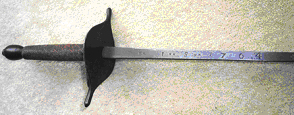
Mid-18th c. English foil |
|
One hundred years later, Joseph Roland in The Amateur of Fencing, 1809, warned against those who twist their bodies, turn their back to avoid being hit, or let their bodies fall so low on the lunge "that you would imagine they were paying homage to the adversary's toe; so that by these, and numerous other elegant motions, they will often prevent the adversary being able to hit or aim at the breast, which is the only place where the touches are counted in fencing". He explained that the reason why hits were valid only on the breast was to make fencing as safe as possible, saying "if a hit at any part of the body was to be counted as good, the art would become quite in disuse, as no one would practice it, if attended at every lunge with the danger of being injured for life". That it should be necessary to warn of the dangers of injury in the first decade of the 19th century shows that, some 50 years after its invention, the wire mask was still not in common use.
|
|
The purpose of foil fencing, according to Antoine La Boëssière, son of the inventor of the wire mask, in Traité de l'art des armes, 1818, was to demonstrate the best technique. Archie Corble, in his contribution to Fencing Tactics by Percy Nobbs, 1936, said, "it was customary in the small sword period that a man having parried a thrust should withhold his riposte until his opponent had recovered from the lunge." Good fencers did not advance or retire more than half an inch, but stood their ground and made attacks preceded by small beats. At the end of a bout the left foot should be in exactly the same place as at the start. This high degree of technical dexterity could only be maintained for three or four hits before the fencers took a rest, placing the heel of the right foot against the left ankle to preserve the position.
|
|
By 1836 when the mask had finally been generally accepted, Barthélemy De Bast pointed out in his Manuel d'Escrime that, since a public fencing match was the goal towards which all lessons led, it should be undertaken with the same seriousness as a duel. A match was preceded by an elaborate demonstration of technique and precision known as tirer au mur, followed by the salute. It was expected that each fencer would announce a hit received in a loud voice. |
|
George Chapman maintained in Foil Practice, 1861, that hits counted only if delivered between neck and waist "provided that the players do not purposely hide the breast with the sword arm or by contortions of the body". And in a sequel published in 1864 he added, "In such cases, all hits upon any part of the person above the hips should be accounted good".
|
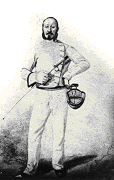
Mid-19th c. Victorian foilist |
|
|
The first annual foil competitions in Britain were introduced at the Royal Military Tournament in 1880, with bouts fought for five hits on a platform 24 ft x 4 ft. If a fencer stepped off the platform with either foot, he lost a hit. Jackets were made of a white material and foil points were covered with "a black preparation" to aid judging. |
|
Despite previous broad identification of the target as being between neck and hips, in 1891 Alfred Hutton's The Swordsman defined the target more precisely as "from the lower edge of the collar bone to the waist, and bound vertically on the inside by a line passing over the left nipple and on the outside by a line passing over the forward part of the armpit".
|
The year 1896 was a significant one in the history of fencing for three reasons:
1. Rules for civilian competitions in Britain were first drawn up by the Amateur Gymnastic & Fencing Association. They reflected those adopted by the Royal Tournament, except that the width of the piste was extended to 6 ft. Hits were valid between neck and hips, and included the mask or arms if covering the target. The buttons of foils were coloured to aid the referee and judges, and competitors were expected to acknowledge hits. Any fencer wilfully refraining from acknowledging had a point scored against him for each offence.
2. The first modern Olympic Games gave a great stimulus to fencing as a sport with the inclusion of foil and sabre competitions.
3. Later that year the first open international three-weapon events were held in Paris, with separate competitions for amateurs and professionals. The winner of each event received 1000 francs and every participant received a bronze medal commemorating the tournament. |
|

English prize foil dated 1892 |
|
When the Amateur Fencing Association was formed in 1901, bouts were for three hits, but unorthodox fencers could sometimes beat skilled opponents with a few lucky touches. So, in 1905, the scoring system was changed to an unlimited number of hits within a 5-minute period, taking into account the quality of the fencing as well as the hits scored. At the end of the final bout of the foil championship that year between Robert Montgomerie and Edgar Seligman, both previously unbeaten, the score in hits was 5-4 to Seligman, but Montgomerie was declared the winner because of his superior style. In practice, however, the judging of style proved to be too inconsistent and was soon dropped.
|
|
The first British foil championship was held in 1898 and the winner was not required to fence in the following year's championship until the final poule. Only in 1910 did the champion have to fence through the competition like everyone else.
|
|
Fencing started to become an acceptable pastime for women in the late 1880s, when the Prince of Wales sent his three daughters to Baptiste Bertrand for instruction. At the same time, 15-year-old Toupie Lowther was being taught by ex-army instructor William McPherson; within 10 years, she had established herself as the most formidable woman fencer of her generation, defeating all her opponents, including many men. But she had retired by the time the first British women's foil championship was held in 1907, Millicent Hall winning from a field of 37 competitors. It was not until 1924 that women's foil was accepted at the Olympic Games.
|
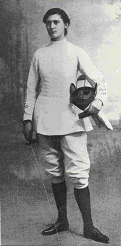
Toupie Lowther |
|
Anxious to make foil fencing more practical, the French Ministry of War in its Reglement D'Escrime, 1908, introduced new regulations that extended the target (for men) to include the lines of the groin and the upper sword arm from shoulder to elbow. When the organisers of the 1912 Olympics reverted to the old target definition of the body between neck and hips, the French team withdrew in protest. The time had clearly come for an international body to draw up a set of rules that everyone would adhere to and, in 1913, the FIE was formed. Its basic specifications for the foil hold good to this day: blades must be not more than 900 mm long, guards not more than 120 mm in diameter and 30-55 mm deep, and total weight not more than 500 g. |
|
Although the upper arm was part of the valid target at the 1920 Olympics, it was excluded three years later, too late for the young Italian star Aldo Nadi, who famously lost the most publicised match of the 20th century to Lucien Gaudin of France in 1922, complaining bitterly that several hits had been given against him when they landed on his arm.
|
|
For women, the lower limit of the target remained at a line drawn across the top of the hipbones and in 1938 the FIE ruled that it should be marked by a black ribbon sewed across the jacket. In 1964 the women's target was finally made the same as the men's.
|
|
For more than 200 years the shape of the handle was a simple choice between French and Italian. After a period in the 18th century when foils were fitted with oval handles to resemble their small sword counterparts, the French adopted the more practical square shape, which offered a high degree of blade manipulation. By contrast, the Italians remained faithful to a short rapier-style handle with crossbar over which two fingers were placed to retain strong control of the blade. It was not until the 20th century that a more physical style of fencing made it necessary to develop handles that gave a stronger grip. One of the first fencers to have an orthopedic handle designed to his requirements was the French champion Edouard Gardère, who used it during the 1932 Olympics. Its popularity soon spread and, with the introduction of electric foil, a wide variety of pistol-type handles became available.
|
|
Experiments with electric foil began in the 19th century. Towards the end of his life, the French magician and fencer Robert-Houdin (1805-1871) is said to have invented a metallic jacket linked by wire to a bell that rang when the jacket was touched by a foil point. He gave the rights to this invention to his friend, the fencing master Augustin Cabot, who registered a patent in 1895. Another electric scoring apparatus was developed in Belgium in 1885 and in 1896 the English surgeon Muirhead Little invented a similar device involving an electric wire connecting a jacket woven with copper thread to a wall-mounted recorder. But, although these inventions were successfully demonstrated, the sight of two fencers moving up and down the piste on wires like a couple of captive beetles caused such hilarity among spectators that the systems lost all credibility.
|
|

Electric foil demonstration in 1896 |
|
It was not until 1935 that the familiar reel and ground lead system was first tried out using a Hungarian scoring machine at a women's foil match in Germany. Two years later the FIE initiated the first men's foil international electric tournament in Brussels, using an Italian system and supplying weapons, lamé jackets and body wires for the event. In 1938 Bela de Tuscan, a Hungarian-born fencing master from Detroit, and his wife Joanna demonstrated his invention of a battery-operated system on stage in London. World War II put a stop to further development.
After the war, an experimental electric poule at the 1950 world championships was won by Britain's René Paul. But only in 1955 did enough reliable equipment become available for the foil events at the world championships to be fenced electric for the first time. However, the blades were about 65 g heavier than non-electric ones and the resulting lack of balance caused many foilists to give up the weapon in disgust. But the best fencers adjusted, as demonstrated by the Frenchman Christian D'Oriola, who won the gold medal at both the non-electric 1952 Olympics and the electric 1956 Games. In those early days, it was felt that referees would be so pressurised that they would not be able to work for more than 15 minutes at a time.
At the 1955 world championships the Russians demonstrated an invention that was suggested could replace the costly electric foil. It consisted of a hollow spring-loaded point containing a wad of cotton wool that was impregnated with a mix of water, red dye and ammonia before each bout. When a hit was made that caused the point to be depressed, a red mark appeared, disappearing a few seconds later depending on the amount of ammonia in the mixture. But, apart from the inconvenience of having to regularly replenish the mixture, the system did not work on metal and so off-target hits on the mask did not register. Like other ingenious devices for recording hits developed over the previous 250 years, it passed into oblivion.
Early electric tips had a distinctive beehive shape with horizontal and vertical ridges, then in 1958 the vertical ridges were removed and in 1961 a flat tip with sharp edges was introduced. Seven years later the bevelled edge version that we know today became the standard shape, although its diameter has changed over the years.
But blades continued to break, sometimes with fatal consequences and it was only in 1995 that maraging steel, a high-strength iron-nickel alloy, was introduced for foil and epee blades, which not only lasted longer than blades made of spring steel, but also tended to fail progressively so that they could be discarded before breaking.
All wired links in electrical fencing can develop faults and ever since Wilkinson Sword began experimenting with radio transmitters in the 1950s, engineers have been trying to develop a reliable wireless scoring system. A promising French invention was demonstrated in the 1960s, but was never funded to commercial development, and it was not until the late 1990s that a Ukrainian company, StM, introduced a system, initially for sabre, that worked reliably. It was used at the world championships for the first time in 2001 and at the Olympics in 2004, before being adapted to epee at the 2007 world championships and finally to foil at the 2008 Olympics. Since then it has been used in the final stages of all major tournaments.
Competitors wear a special conductive T-shirt next to their skin. A hit activates a transmitter attached to the fencer's waist, which triggers a light on the mask and transmits a signal to the scoreboard in the arena. A sophisticated encoding system solves problems of interference from any other transmitter.
|
Epee
|
|
Paradoxically, it was the adoption of the mask that led to epee fencing. Although duelling had been outlawed for centuries, it continued to take place, particularly in France and Italy, where fencing masters would adapt their foil lessons to the practical preparation for a serious encounter with the épée de combat. The more mobile and dynamic form of fencing allowed by wearing masks blurred the distinction between academic foil play and duelling practice, leading some fencers to think that foil technique was a suitable preparation for fighting a duel. By the mid-19th century some French fencers were beginning to rebel against this teaching, which left many competent foilists dead or wounded when involved in a duel. The Baron de Bazancourt in his entertaining book Les Secrets de L’Epée, 1862 (translated as Secrets of the Sword, 1900), put forward the revolutionary argument that fencing should represent real fighting as closely as possible.
|
| Writing in The Sword (Summer 1949), Luke Fildes, President of the Epee Club, said: "Had it not been for this strictly practical purpose [preparation for a duel], there is no reason for thinking epee fencing ever would have come into existence." |
| In the first issue of Les Armes (15 May 1905), Horia Rosetti outlined the introduction of epee fencing. Before 1860, he said, epee was never seen in fencing clubs. At that time, those who had to fight a duel would go to the Parisian fencing master Gatechair to learn how to handle an epee in what became known as the "widow's lesson". His assistant Jules Jacob began specialising in the teaching of epee and soon attracted a following of discontented foilists keen to practise a more realistic form of swordplay. Once invented, this new kind of fencing was found to have merits quite apart from its practical use. The epee became a weapon of sport as well as of combat and its practitioners had to develop the duellist mentality: hit without being hit. |

Pair of mid-19th c. French epees |
|
Initially, bouts were for a single hit and if fencers hit simultaneously they suffered a double defeat. But if, in the opinion of four judges and a president, an appreciable length of time had elapsed before the second hit arrived, only the first hit counted. Any one of the judges or president could call halt if they saw a hit arrive; they would then confer before deciding what had happened. The difficulty of judging whether a hit was good or not led the French fencing master Ambroise Baudry to invent a single pointe d'arret in 1883 – a sharp tip protruding 2 mm from its cord binding designed to catch in a fencer's canvas jacket.
|
|
Before 1890, the French manufacturer Souzy offered guards in two sizes – 95 mm and 110 mm diameter – but, as epee competitions became more frequent, the diameter gradually increased to provide greater protection for the hand. However, there were many fencers who regarded hits to hand and wrist as the highest form of epee and they favoured the smaller diameter guard. In 1896 the Societé d'Escrime à l'Epée de Paris agreed on a specification for epee that became the international standard when adopted by the FIE in 1914. Blade length was not more than 900 mm, maximum guard diameter was 132 mm, depth 50 mm and eccentricity not more than 35 mm, the pommel was cone-shaped, 60 mm long x 30 mm diameter at the end and 18 mm at the handle, and maximum overall weight was 770 g. |
|
In June 1896 separate international open tournaments for professionals and amateurs were held in Paris for the first time. Among the epee amateurs there were three Englishmen: Felix Clay, Capt. Hampden Wigram and John Norbury. The 72 competitors were divided into nine poules of eight from which only one was promoted to a final poule of nine. Blades could be triangular, diamond section if Italian, or even square. The winner of each event received 1000 francs and every participant received a bronze medal commemorating the tournament.
|

Late 19th c. French epee
|
|
|
The longest recorded bout took place at the Paris international epee tournament of 1897 where there was no time limit and fights were for one hit, broken up into fencing periods of 5 minutes followed by 2 minutes rest. Two Frenchmen fought for 1 hour 25 minutes without scoring, broke for lunch and continued for a further 25 minutes before one of them finally made a hit that was seen by the judges – a total of 2½ hours including rest periods. |
|
| |

English prize epee dated 1877 |
Epee fencing had been practised in Britain for some years among friends. The earliest known dated epees are a pair presented as a prize at the Edinburgh Collegiate School in 1877. But it was not formally taken up until Charles Newton-Robinson founded the Epee Club in 1900 with the purpose of encouraging the use of epee in the open air by regular summer poules among members. |
|
The Club began holding an international open competition in 1901 and at the fourth one in 1904 the French club Les Armes de France presented a handsome Art Nouveau bronze shield to the Amateur Fencing Association (AFA) to be awarded to the highest placed British fencer – Edgar Seligman, who came 7th. The AFA recognised him as the first British epee champion and in 1908 started organising its own championship.
|
| In 1906, the Epee Club began to try out the single pointe d'arrêt to aid scoring. But by then the continental Europeans had decided it was rather dangerous and adopted the invention of another French fencing master, Léon Sazie, the triple point. It was sometimes used with a wad of water-based paint tied between the prongs to add visual proof of a hit. |
|
Also in 1906 in France, Dr Doyen patented the first orthopaedic grip, an aluminium handle moulded to the shape of the hand. A further half dozen shapes became available in the decades before World War II.
|

The Doyen handle |
|
|
|
Because one-hit epee sometimes allowed the less skilful fencer to score a fluke hit and led to an over-cautious approach that spectators found boring, tournaments began experimenting with two- or three-hit bouts. But at the 1912 Olympics in Stockholm, where triangular or lozenge-shaped blades were allowed, one hit was still the rule, as it was at the international tournament of 1913 in London, when a time limit of 15 minutes was introduced. To ensure that valid hits were seen, the organisers applied a colouring matter to the point. Since there was no neutralising agent available, a pencil cross was put over each mark as hits were scored. Towards the end of the competition, it became increasingly difficult for the judges to see whether a new mark had appeared on heavily spotted jackets.
The 1912 Olympics, already marred by the withdrawal of the French team over the foil target, was the scene of another walk-out when the Italians withdrew from the epee events in protest when their blades, which exceeded the 900 mm limit, were banned. The FIE's time had come.
In order to reproduce as closely as possible the conditions of a duel, most epee tournaments before World War II were fenced in the open air on gravel paths. By 1925, bouts of two or three hits were commonplace and at the 1927 European championships, the final was to ten hits. But this was exceptional and in 1931 the three-hit bout was formally adopted, becoming five hits at the 1953 world championships. |
|

Early 20th c. epee fencing |
|
The problem of ensuring that hits were accurately recorded, particularly on the mask, exercised epeeists throughout the early decades of the 20th century. At the third international fencing congress of 1905, no fewer than nine different designs of bouton marqueur were considered for adoption without any being considered altogether suitable. |
| The first battery-operated system combining a bouton marqueur and electric epee wired to a small illuminated box strapped to a fencer's shoulder, the Electrophone, was patented by Souzy in 1914 and favourably reviewed in L'Escrime et le Tir in 1926, but it was too impractical to be generally adopted. Although various other ingenious recording systems were developed, it was not until 1931 that the Swiss engineer Laurent Pagon demonstrated a reliable system and the FIE held the first international electric tournament in Geneva – won by Paul Anspach of Belgium with Charles de Beaumont second – using epees with a spring-loaded four-pronged tip. Three years later Souzy patented the Valentin system, used at the European championships for the first time in 1934, and this soon became the universal standard. |
| Electric epee was first used at Olympic/World Championship level at the 1936 Olympics, when two types of connection were allowed: the now conventional straight 3-pin connector inside the guard and a circular 3-pin socket built into the end of the pommel. In 1938 electric epee was used in the British championship for the first time. The following year, Castello-Emerson in the USA introduced the ultimate bouton marqueur, a device that connected a four-pronged tip to a barrel containing a red liquid. Sold in 1 oz bottles, the dye could be removed from jackets with vinegar. |
| After the war, Dr Ron Parfitt invented the first British electrical apparatus, which was sold by Leon Paul from 1948. Despite these inventions and the regular use of electric epee at major championships, the high cost of electrical equipment ensured that the cheap triple point tied to a flattened tip continued to be used in many clubs well into the 1960s. |
|
|
| 
French pre-war electric epee box |
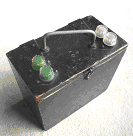
English post-war electric epee box |
|
As soon as scoring moved away from the single hit, the duellist mentality began to fade. The leading French epeeist René Monal was one of the first to take electric epee to its logical conclusion, changing forever the weapon's golden rule from 'hit without being hit' to 'hit 1/25th of a second before your opponent hits you'. His speciality was the fleche to body and in the 1937 World University Games in Paris he ran on to his opponent's blade which snapped, the broken stump penetrating his heart. Monal dropped dead after the electrical apparatus had recorded his winning hit.
It was another fatality in 1951 that led to the four-pronged electric tip being changed to a pineapple shape in 1953. Finally, in 1968 the familiar bevelled-edge flat tip used today was introduced.
Although there are photographs of women fencing epee in the 1930s, the first individual and team world championships for women were not held until 1988 and their epee events were admitted to the Olympic Games only in 1996.
|
Sabre
|
|
Sabre fencing derives from the heavy military sword and naval cutlass, wooden or blunted versions of which were used for centuries in preparation for warfare. The first purpose-made practice sabre was the 16th century German düsak, a heavy curved sword, usually made of wood but sometimes of steel, with a hole in the grip for the hand.
|
| More popular in Britain was the cudgel or singlestick, which developed into a rural sport during the 17th century. Young farm workers would gather at country fairs and take part in bouts using an ash stick held in a wicker basket. The winner was the first man to deliver a blow that caused an inch of blood to flow from his opponent's head.
|

English 19th c. singlestick |
|
|
Singlestick fighting was also taken up by the armed services as a preparation for swordplay. In his book Broad-Sword and Single-Stick, 1890, C Phillipps-Wolley wrote, "There is just enough sting in the ash-plant's kiss, when it catches you on the softer parts of your thigh, your funny bone or your wrist, to keep you wide awake and remind you of the good old rule of grin-and-bear-it." |
|
|
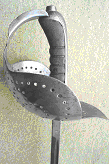
English 1899 pattern gymnasium sword |
In 1856 the British army introduced the first purpose-made cavalry practice sword and 8 years later its gymnasium equivalent. With various modifications, these weapons continued to be made until 1911, when the last gymnasium sword was introduced. The early years of the Royal Tournament, which developed into the biggest military tattoo in the world, included sabre v bayonet (1886) and sabre v sabre (1891). |
|
At the same time, modern sabre fencing was being developed in Hungary and Italy, where the sabre was a popular duelling weapon. In 1851 the Hungarian fencing master Joseph Keresztessy opened a school that taught a new style of fencing using circular wrist motions as the basis for cuts and parries. Then, in the 1870s, the Italian fencing master Giuseppe Radaelli developed a light sporting sabre, with a thin triangular blade and a simple elliptical ring surrounding a narrow knuckle guard. It had a slightly curved blade 820-880 mm long tapering from 12 mm wide at the guard to 8 mm at the tip and weighed just 450 g. Soon Italian fencing masters were demonstrating the new system all over Europe. Luigi Barbasetti introduced it to Austria, Italo Santelli to Hungary and Giuseppe Magrini to Britain.
|
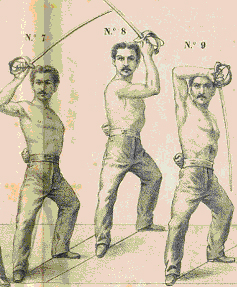
Radelli's light sporting sabre |
|
|
The new lightweight sabre was used in competition at the first modern Olympic Games of 1896. Looked on with derision by army fencers, the sporting sabre was first demonstrated in England in 1893, when the inspector of gymnasia at Aldershot, Col. Fox, brought over the celebrated master Ferdinando Masiello of Florence with his pupil Giuseppe Magrini, who was to settle in this country and teach sabre in the army until his death in 1912. |
|
In his book Cut and Thrust, 1927, Léon Bertrand vividly described an encounter between Magrini and a traditional army fencer: "Magrini was a resplendent figure in black satin knee-breeches and silk stockings, waving a light and fragile-looking silver-plated sabre. In contrast Mr X was lifted on to the platform at the other end, clad in heavy canvas, shin guards and cage-like mask, clutching a heavy blunted cavalry sword. With gossamer touch, Magrini drew his blade swiftly across the chest to draw 'first blood'. Mr X, who had made one wild attempt to follow the steel, abandoned defence and cut wildly at head. The flat of the blade curled over Magrini's mask and he received the full force of the blow on his back. Believing his first impression of British sabre-play too bad - and too painful - to be true, Magrini advanced to the attack once more. Following a couple of bewildering feints came the circular cut with feathery touch. Once again Mr X floundered, hit out blindly, and for the second time his blade curled down the Italian's spine, whereupon Magrini whipped off his mask, held out his hand and, despite his obvious agony, said distinctly, 'Thank you, sir. You are a very much better man than I'."
|
|
|

Italian late 19th c. sporting sabre |
|
The first British sabre championship was held in 1898. As with foil, the winner was not required to fence in the following year's championship until the final poule and only in 1910 did the champion have to fence through the competition like everyone else.
|
|
At the 1908 Olympics in London specifications for sabre were: blade length not more than 880 mm (extended to 900 mm for the 1912 Olympics), guard 150 mm wide x 140 mm deep and maximum overall weight 500 g. These dimensions were later to be adopted by the FIE. But sabre was still regarded as essentially a military weapon and, in preparation for combat, the whole body was the target. It was only after the First World War that the modern sabre target was adopted.
|
|
|
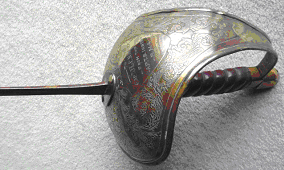
English 20th c. prize sabre made by Wilkinson |
|
Sabre fencing continued to require the services of four judges and a referee well after the other two weapons became electrified, but eventually in 1986 a reliable system of recording hits electrically was perfected. The sudden contact of blade against metallic jacket, mask or bib triggers an electric circuit by way of a socket inside the guard connected to a bodywire and then to a reel and ground lead to activate a scoring machine.
|
|
Women's sabre became recognised in 1998 with a trial event at the world championships and the following year official individual and team events were held, with full parity at the Olympic Games achieved in 2008.
|

![]()
















